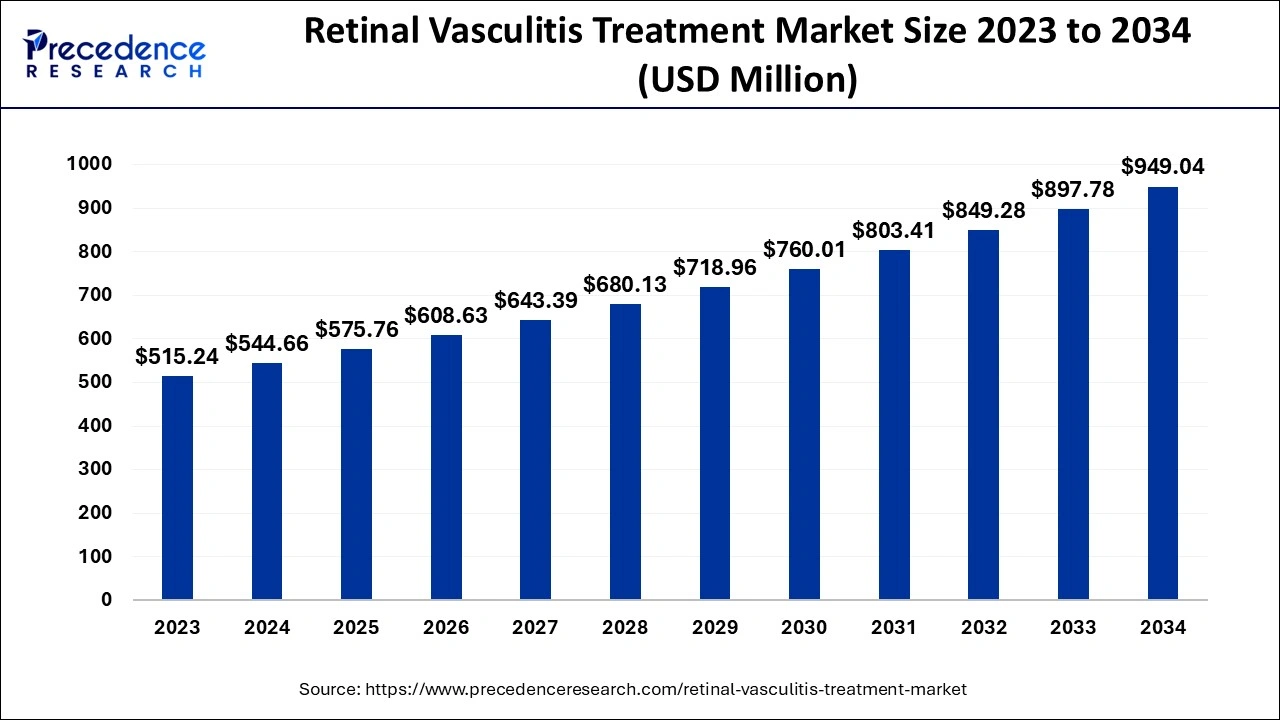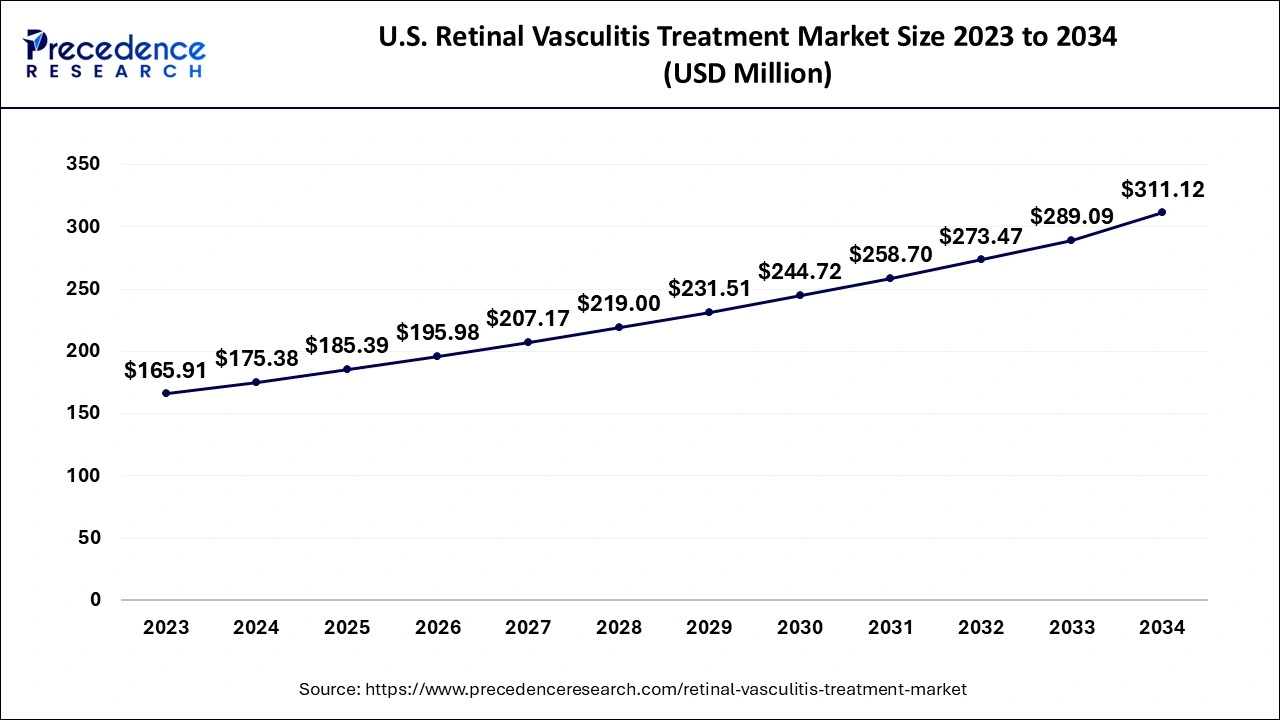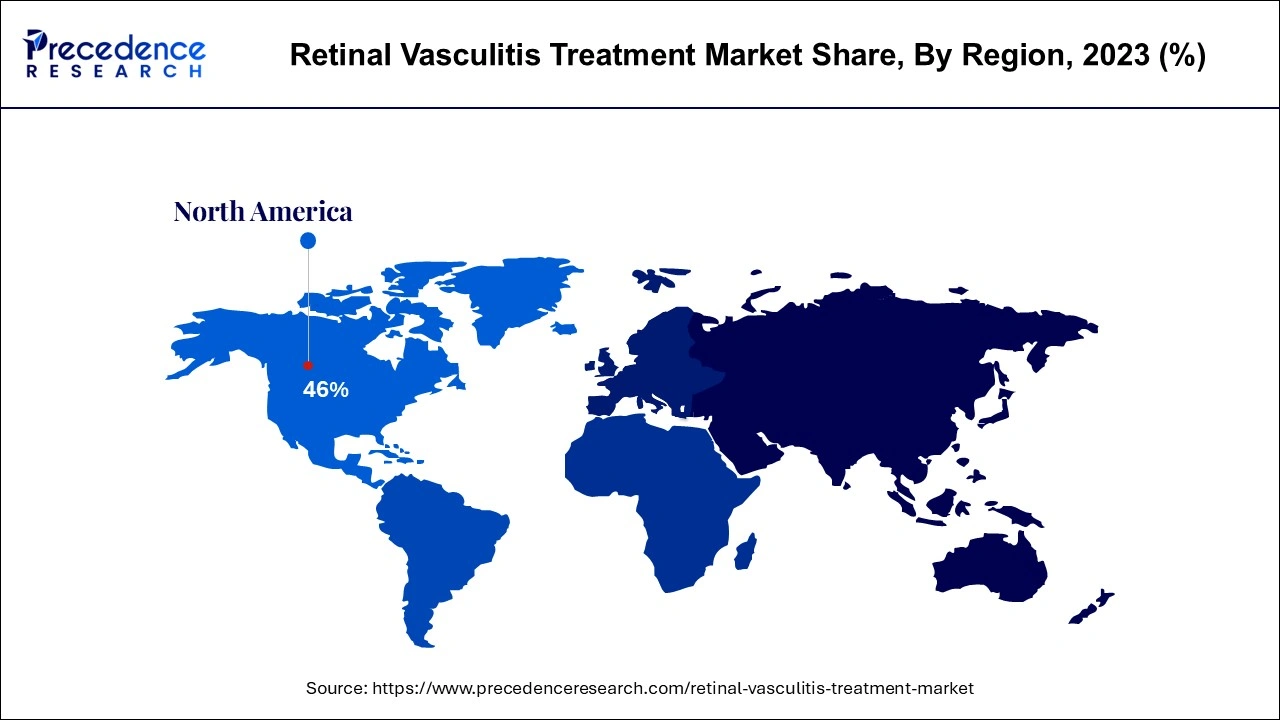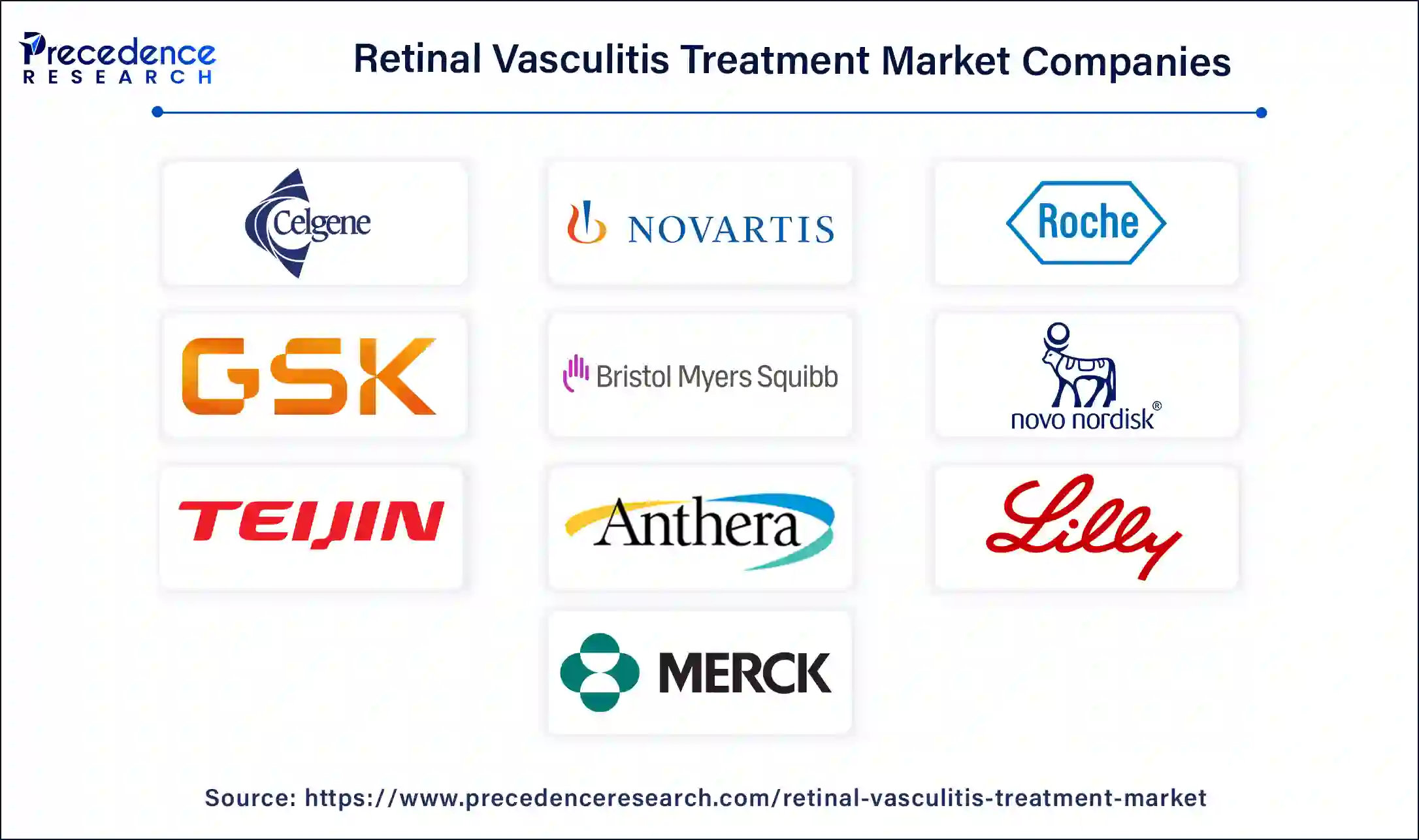March 2025
The global retinal vasculitis treatment market size accounted for USD 544.26 million in 2024, grew to USD 575.76 million in 2025 and is predicted to be worth around USD 949.09 million by 2034, registering a CAGR of 5.71% between 2024 and 2034. The North America retinal vasculitis treatment market size is evaluated at USD 250.54 million in 2024 and is estimated to grow at CAGR of 5.81% during the forecast period.
The global retinal vasculitis treatment market size is calculated at USD 544.66 million in 2024 and is projected to surpass around USD 949.04 million by 2034, expanding at a CAGR of 5.71% from 2024 to 2034. The retinal vasculitis treatment market is driven by the increasing number of people with systemic autoimmune disorders.

The U.S. retinal vasculitis treatment market size is exhibited at USD 175.38 million in 2024 and is anticipated to reach around USD 311.12 million by 2034, growing at a CAGR of 5.88% from 2024 to 2034.

North America dominated the retinal vasculitis treatment market in 2023. Numerous renowned biotech and pharmaceutical companies with significant R&D expenditures are based in North America. This area conducts a large number of clinical studies for novel treatments and medications that target retinal vasculitis, which results in the release of cutting-edge therapeutic alternatives. Numerous therapy alternatives are available, like immunosuppressants and corticosteroids. This variety improves the effectiveness of treatment and meets the needs of different patients.

Asia Pacific is observed to host the fastest-growing retinal vasculitis treatment market during the forecast period. Higher diagnosis rates result from increased public and healthcare professional awareness of retinal disorders. One reason contributing to the increasing number of patients seeking retinal vasculitis treatment is the development of chronic inflammatory illnesses. Early detection rates are rising due to public health efforts aimed at educating the public about eye health and disease prevention.
Retinal vasculitis, a disorder involving inflammation of the retina's blood vessels, can cause blindness or significant vision impairment. It is linked to several infectious diseases, which are becoming more prevalent worldwide, and systemic autoimmune illnesses like lupus and Behçet's disease. The retinal vasculitis treatment market will see opportunities as the population ages and autoimmune illnesses become more common. This will increase the demand for efficient therapies. Prevention of disorders related to vision is becoming more and more important to governments and healthcare institutions.
Through grants, financing schemes, and regulatory incentives such as orphan drug designations, which promote the discovery of medicines for uncommon diseases, there is increasing support for research into retinal diseases, including vasculitis.
How is AI Helping the Retinal Vasculitis Treatment Market Grow?
Artificial intelligence and deep learning algorithms have brought about a paradigm shift in medical image processing, particularly in the retinal vasculitis treatment market. Minimal features in retinal images can be effectively extracted and analyzed by artificial intelligence (AI) technologies, which can reveal subtle retinal manifestations that may not be visible to the human eye. Even before any obvious symptoms or indicators appear, this enhanced imaging analysis employing AI can help screen and diagnose systemic disorders at their subclinical stage.
By examining changes in the retina, AI may help forecast the likelihood of systemic diseases. Moreover, AI algorithms can create prediction models to identify people who are more likely to acquire retinal disorders by combining primary data from retinal imaging findings from patients with systemic diseases like diabetes mellitus.
| Report Coverage | Details |
| Market Size by 2034 | USD 949.04 Million |
| Market Size in 2024 | USD 544.66 Million |
| Market Size in 2025 | USD 575.76 Million |
| Market Growth Rate from 2024 to 2034 | CAGR of 5.71% |
| Largest Market | North America |
| Base Year | 2023 |
| Forecast Period | 2024 to 2034 |
| Segments Covered | Infection Type, Drug Type, and Regions |
| Regions Covered | North America, Europe, Asia-Pacific, Latin America and Middle East & Africa |
Growing cases of infectious causes
Treatment for infections has become more difficult due to the advent of drug-resistant organisms, such as multi-drug-resistant tuberculosis (MDR-TB) and antibiotic-resistant bacterial infections. This makes the disease last longer and raises the possibility of side effects like retinal vasculitis. The need for retinal vasculitis treatment market services, including therapies for related disorders such as retinal vasculitis, increases while treating drug-resistant infections since they typically stay longer and are more challenging to cure.
Increasing use of biologics
Large, complex molecules called biologics which include proteins, antibodies, and other medicines, are made from live cells. Bibiliars have become an important therapeutic option for treating retinal vasculitis, characterized by inflammation of the retina's blood vessels, because of their specific mode of action. Biologics' precise ability to regulate the immune system and inflammatory pathways has made them a vital factor in the market expansion for treatments for retinal vasculitis.
High cost of treatment
Advanced diagnostic techniques such as fundus photography, fluorescein angiography, and optical coherence tomography (OCT) are necessary in the retinal vasculitis treatment market. These imaging modalities are important for making the diagnosis, determining the degree of inflammation, and tracking the effectiveness of treatment over time. When retinal vasculitis first appears, it could take several diagnostic tests to distinguish it from other retinal illnesses.
In the retinal vasculitis treatment market, due to the high cost and potential lack of comprehensive insurance coverage in many areas, these tests are not available to people with low incomes. Patients with retinal vasculitis must have imaging and follow-up visits regularly because the condition might deteriorate or flare up over time. Both patients and healthcare systems may experience severe financial hardship due to the cumulative expense of continuous monitoring.
Advances in biological treatments
Advancements in biotechnology are making a shift towards personalized medicine in the retinal vasculitis treatment market, where therapies are customized based on unique patient profiles. The best biological therapy can be chosen with genetic biomarkers, imaging methods, and knowledge of each patient's distinct immune response. For instance, determining cytokine profiles in a patient's serum or aqueous humor might help direct the administration of inhibitors, such as TNF-α blockers or IL-6, to ensure the best possible results.
The bacterial segment dominated the retinal vasculitis treatment retinal vasculitis treatment market in 2023. Retinal vasculitis, which can result in inflammation and possibly blindness, is frequently brought on by bacterial infections. Vasculitis can be brought on by illnesses like bacterial endophthalmitis, resulting in a sizable patient population needing care. When retinal vasculitis cases are thought to have bacterial origins, many professional guidelines advise initiating antibiotic therapy immediately. Physicians are encouraged to use these treatments more extensively because of support from governing bodies in the healthcare industry.
The viral segment is observed to grow at the fastest rate in the retinal vasculitis treatment market during the forecast period. Retinal vasculitis linked to these disorders has been identified earlier thanks to increased awareness of and capacity for diagnosing viral infections. The need for efficient treatment alternatives is being driven by this heightened awareness. The demand for better treatment alternatives is being driven by rising healthcare spending internationally, especially in places with greater rates of retinal disorders. Healthcare systems that invest more in ocular health and specialized treatments stand to gain a great deal from the viral category.
The oral corticosteroid segment dominated the global retinal vasculitis treatment market in 2023. It is commonly known that oral corticosteroids have strong anti-inflammatory effects. If left untreated, retinal vasculitis, characterized by retinal blood vessel inflammation, generally results in severe visual impairment. By successfully reducing inflammation, corticosteroids relieve symptoms and stop more eye damage. Many patients choose oral drugs because oral dosage is more convenient than injections or infusions. With oral corticosteroids, more patient compliance is frequently seen, which can improve treatment outcomes and, as a result, increase their market share.
The immunosuppressive agents segment will grow significantly in the retinal vasculitis treatment market during the forecast period. Retinal vasculitis is becoming more common; it is frequently linked to autoimmune disorders and systemic ailments such as sarcoidosis and Behçet's disease. The requirement for immunosuppressive medications is being driven by the rising prevalence, which calls for efficient treatment solutions. Immunosuppressive drugs are more popular due to the shift toward tailored treatment plans, where doctors adjust patient-specific regimens according to the severity of the illness and patient characteristics.

Segments Covered in the Report
By Infection Type
By Drug Type
By Geography
For inquiries regarding discounts, bulk purchases, or customization requests, please contact us at sales@precedenceresearch.com
No cookie-cutter, only authentic analysis – take the 1st step to become a Precedence Research client
March 2025
January 2025
January 2025
May 2024